Applied
Microeconomics
Lecture 23
BE 300
Plan for Today
Multi-part pricing (cont).
Bundling
Coming Up
"Bundles of Joy" Case Due Next Time.
Please bring your laptop to the next class.
Final Exam
•Format: Multiple choice and short answer
•Cheat Sheet permitted (8.5x11/2-sided); otherwise, closed book, closed notes.
•You can and should bring your own calculator
•Bring a #2 pencil for multiple choice answers (which you will enter on a Scantron sheet)
•No partial credit given on multiple choice
•Credit on short answer only if work is shown
•COVERAGE: Focus is on topics since the midterm but “cumulative in concepts”
Two Part Pricing
Last week we discussed "two part pricing" or "razor-razorblade" pricing.
Ex: Nespresso machine and pods
Printer and ink
Razor and razorblades etc.
If customers have different demands, but it is hard to distinguish the elastic vs. inelastic customers, it makes sense to lower the price of the upfront good (nespresso machine) and mark up the per unit good (nespresso pods).
Tying
Two part pricing is one example of tying.
Tying: requiring that a buyer of one product also buy one or more other products from the same firm.
Why use this strategy?
Tying
Reason one: price discrimination (as we saw last time)
- If consumers vary in their demand for the good, two part pricing can be used to extract more surplus from the high demanders (who will choose to purchase more)
Tying
Reason two: quality assurance
-
Common features of mainframe computers, copiers, and shoe machines:
All durable, complex machinery, prone to breakdowns and in frequent need of repair.
-
Often you are required to purchase service agreement.
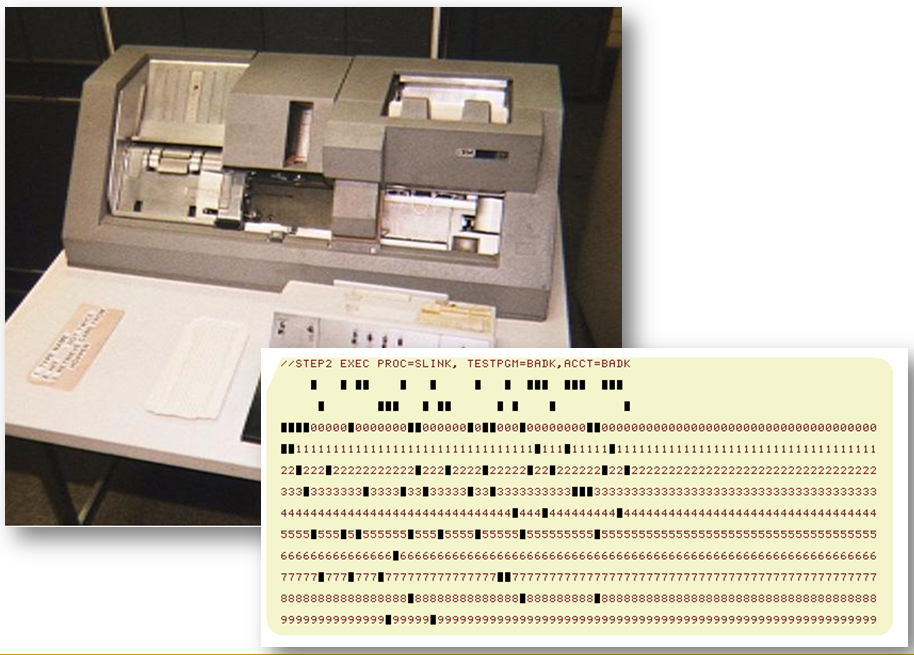
Tying
“The average of two to three system failures per day is not at all unusual for medium-size business data processing systems. In fact, Yourdon reports that larger systems like the IBM 360/91 and 360/95 usually suffer four or five system failures per day, and he mentions that CDC established a goal of reducing failure on their 7600 systems to an acceptable level of fifty per month.” (Phister, 1974)
Mainframe Computers
Tying
If a company’s reputation is not enough to make promises credible, tying serves to guarantee quality and repairs by making the manufacturer’s profits dependent on machine use, giving the manufacturer an incentive to produce quality machines and to repair machine failures promptly.
Bundling
Bundling: selling two or more distinct products as a package (at a single price).
Bundling
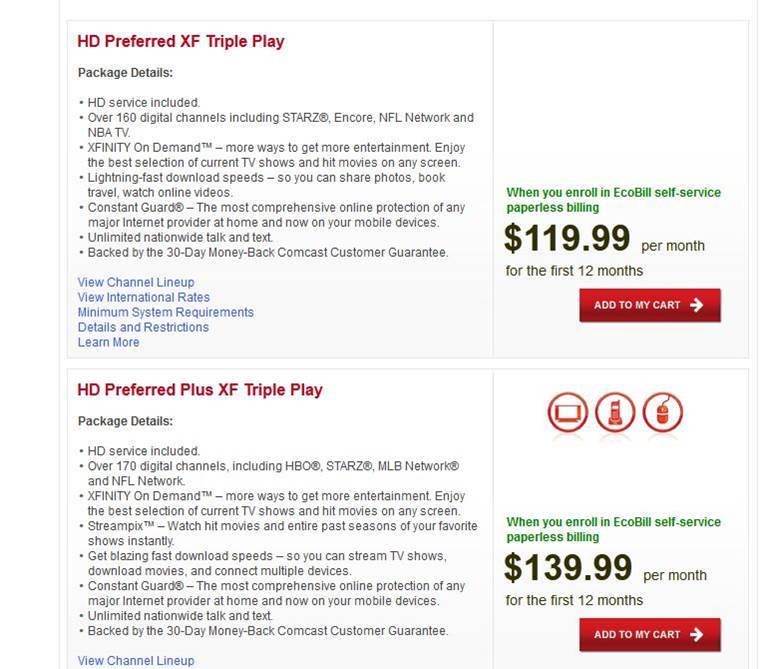
Can make it difficult to fine tune your bill to avoid paying for unused services.
What if you want HBO but don’t want MLB and NFL Network?
Note: it costs $20 to add HBO and Sports networks in this bundle.
Bundling

Now suppose you have basic cable and want to add HBO and Sports.
•You can only add HBO if you spend $80 more.
•Even if you have “Digital Preferred” you have to spend $45 to get HBO
Comcast will offer you “a better deal” on the bundle, per service, but only by spending more total dollars. We will see why it is sometimes not best to give all your customers exactly what they want.
**Another example: Comcast also price discriminates inter-temporally by offering different rates to new vs. current customers**
Bundling
Other examples of bundling?
Bundling
Why bundle products?
–Classic example: “Block booking”: long-time practice of movie studios that required theaters to buy movies in “blocks,” thereby “forcing” theaters to buy bad movies (“dogs”) in order to obtain “blockbusters.”
Consider two theaters who value two movies as follows:

Bundling

If you charge a separate price for each movie, what is the maximum you can get (total) for Gone with the Wind?
How about Getting Gertie's Garter?
Bundling

Theater B will not pay more than $7000 for Gone with the Wind.
Theater A will not pay more than $2500 for Getting Gertie's Garter.
So the max you can charge is $7000 for Gone with the Wind and $2500 for Getting Gertie's Garter.
Total revenue-- $7000 + $2500 + $7000 + $2500 = $19000.
Bundling

Now imagine you bundled the two movies and sold them together.
--Can't get one without the other.
What is the max amount Theater A would pay? How about Theater B?
What is total revenue?
Bundling

Hence, by selling the movies as a bundle, the studio can get more revenue than by selling the movies separately.
Bundling makes each consumer's value of the product less dispersed than for the individual goods. $1000 difference in value for GWTW alone--but only $500 difference in value for total product.
Bundling
The values (net of production costs) consumers place on the bundle are less dispersed than for the individual goods.
- Customer demands across 2 products are negatively correlated
Theater A values GWW more than B; B values GGG more than A
•Why? If sold separately, prices must be “lowest common denominators.”
- A would make CS on GWW, and B would make CS on GGG
Bundling
Bundling reduces the dispersion in reservation prices so the firm can charge more and still sell to both customers.
–bundling in effect extracts surplus from A on GWW, from B on GGG
•Thus, bundling can serve as a subtle form of price discrimination without market segmentation.
Bundling: Example

Imagine you have two customers, Alisha and Bob. Their willingness to pay is given in the table. Assume MC or providing the software to download is zero. [note--bundling works best with low or flat MCs]
How much profit will you make if you sell each software separately?
How much profit will you make if you bundle?
Bundling: Example

•The reservation prices are negatively correlated: the customer who has the higher reservation price for one product has the lower reservation price for the other product.
•Pure bundling is more profitable because the firm captures more of the consumers’ potential consumer surplus—their reservation prices.
Bundling: Example

•Now the reservation prices are positively correlated--can bundling increase profits?
Bundling
The great cable un-bundling?
"As streaming services have proliferated, pay TV providers have counted on two things to keep customers from fleeing pricey subscription plans bloated with channels they don’t even watch: live sports and premium networks like HBO. Cracks in the pay TV bundle, however, are rapidly emerging. Last week the NBA began taking preliminary steps towards a cable-free subscription package. And yesterday Time Warner Inc. executive and HBO chief Richard Plepler shocked industry watchers by announcing that in 2015 HBO will offer an online streaming plan to those who’ve ditched their cable subscription."
HBO Unbundled: What It Means for Cord Cutters Forbes 2014
Bundling
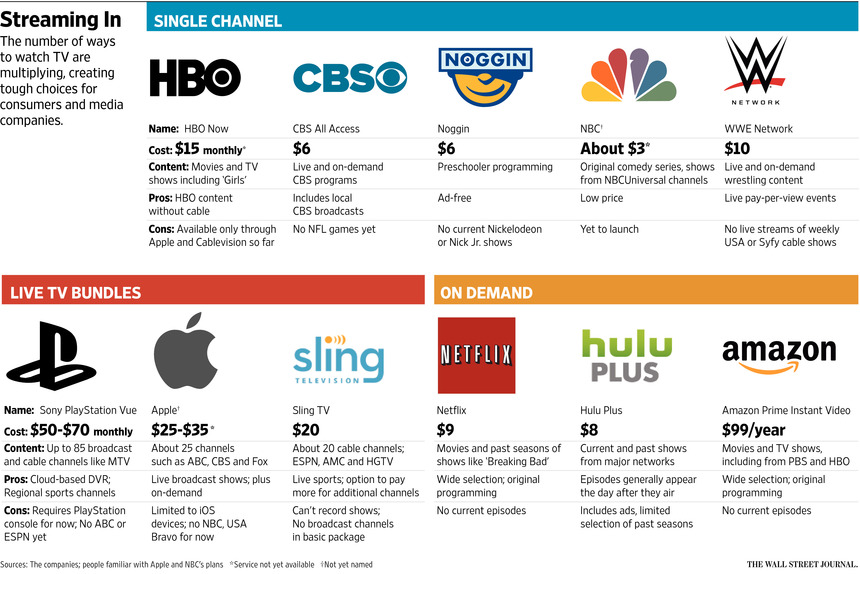
Hat tip: Abhi Satyavarapu
Source: WSJ March 2015
Bundling
The great cable un-bundling?
"On Thursday, just a day after HBO said it would launch a new online streaming service that doesn’t require a cable TV subscription, CBS announced the launch of CBS All Access, a service will let users watch unlimited CBS content, including some live television, on multiple devices for just $5.99 a month."
The Great Unbundling Has Begun, But Be Careful What You Wish For Wired.com 10/2014
Why do you think these cable companies are unbundling?
Do you think this will be good for consumers?
Bundling
More fragmented consumers (possibly due to online competition?)
HBO Sports
- 10 0
- 10 1
- 0 10
- 1 10
- 0 10
Previously you were selling a bundle of both for $10. What happens when you unbundle? Does the firm make more or less money? Are consumers better or worse off?
Bundling
"But there’s another, more subjective dimension in which the rise of unbundled cable service may make us worse off. It’s possible for a market to become more economically efficient while becoming less pleasant for consumers. For a prime example, head to your nearest airport.
A generation ago, buying an airplane ticket meant buying not just a conveyance from one city to another, but an entire bundle of goods. Among them: a seat with enough room to sit comfortably; a meal, a glass of wine or a cocktail; the right to check your bag; the right to trade in your ticket for a ticket at a different time if your plans changed. As fliers have learned all too well in the last decade, air flight has become unbundled. Want a bit of leg room? That will be a $50 upgrade for a seat in your airline’s “premium economy” cabin. Sandwiches are on sale for $9, a glass of wine for $7. Checking that bag costs $25, and there is a $200 change fee for your ticket, or buy a much more expensive one upfront.
In effect, the airline industry has unbundled, so that you pay only for what you want."
(NYTimes Upshot, What Rising Airline Fees Tells Us About the Cable Industry 1/2015)
Bundling
"What does any of this have to do with the unbundling of cable? There are surely examples of people who would be better off in an era of cable unbundling, such as those who watch only a very small number of channels, none of them high-fee sports channels, with great regularity. They are the equivalent of the people who can afford to fly home to Grandma’s house now but couldn’t in a pre-unbundling air transport system.
But for many more people, the result will probably be little or no reduction in total fees, combined with the hassle of making constant decisions about what channels you really want and which you don’t. We already have a small version of that in my household, with the continuing debate of whether to also spring for Netflix while already paying a small fortune in monthly cable bills.
It was the equivalent of the old days when every airline seat had ample legroom and a free drink: You may not know how much you want it until after somebody makes you make the decision to pay.
(NYTimes Upshot, What Rising Airline Fees Tells Us About the Cable Industry 1/2015)
Bundling
For bundling (as a means of price discrimination) to be more profitable than individual pricing, the values (net of production costs) consumers place on the bundle must be less dispersed than for the individual goods (“relative values must be negatively correlated”).
But bundling occurs in many settings where this requirement is not satisfied: Uncut diamonds (De Beers) (and probably movies).
Bundling
Sales: De Beers
- sells several million rough diamonds per year worth approximately $4.25 billion representing approximately 75% of $6 billion international market for uncut diamonds (worth about $45 billion retail). (40% of $9 billion in 2009)


Bundling
Practices: De Beers
- sorts diamonds into approximately 2,000 categories by shape (6), quality (7), color (8), and weight.
- invites about 300 diamond traders 10 times per year to purchase diamonds
- offers diamonds to buyers in “sights” or boxes containing diamonds prepackaged into a number of envelopes or “papers”
- sights are offered on a “take-it-or-leave-it” basis; traders may inspect sights, but traders who reject a sight are deleted from the list of invite
Bundling
In effect, De Beers bundles the sales of diamonds.
- But buyers are middlemen and brokers who resell diamonds to diamond dealers and have roughly the same value for any given diamond, so bundling can’t serve to price discriminate.
So why does De Beers sell diamonds this way?
Bundling
There will be substantial variance cross stones within each “sight.”
- Implies the uncut diamonds are effectively “average priced” for the lot allocated to each buyer
- What are the search costs of trying to find a “diamond in the rough” as the old saying goes?
- Must inspect a lot of diamonds
- Each buyers will inspect more than once
- Leave behind low quality diamonds
Bundling
There will be substantial variance cross stones within each “sight.”
- Implies the uncut diamonds are effectively “average priced” for the lot allocated to each buyer
- What are the search costs of trying to find a “diamond in the rough” as the old saying goes?
- Must inspect a lot of diamonds
- Each buyers will inspect more than once
- Leave behind low quality diamonds
Bundling
Want to avoid costly oversearching
- Each pre-selected buyer is well-informed about the average price of typical rough cut diamonds
- Duplicative searching can have social costs
- Excessive sorting costly to De Beers
- Rejected stones would have to to re-priced at lower revenue and its costly to have another sale.
Bundling
Reason 2 for bundling products:
Avoid wasteful search and sorting costs.
Bundling
Another example: Tuna Harvesting
Species of tuna caught largely beyond control of harvester
- High quality tuna worth more than low quality tuna. Pays to sort high quality tuna for high-value uses and assign low-value tuna to low-value uses.
- However, all U.S. tuna processors (circa 1984) used tuna for the same purposes, so no difference in value depending on whether the tuna went to processor A or processor B.
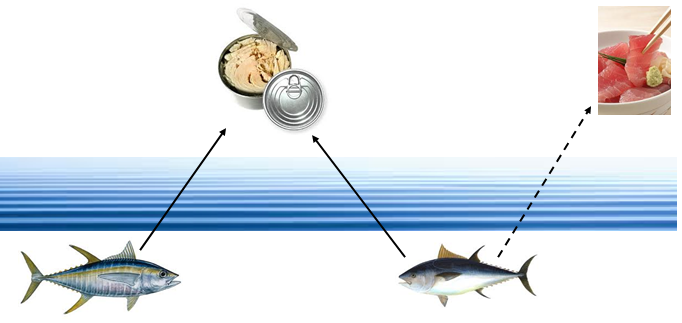
Bundling
Reason 3 for Bundling: Customer convenience.
"Imagine walking into an electronics store to buy a laptop and being told by the salesman that you have to pick out a motherboard, power supply, processor, monitor, hard drive, video card, screen, keyboard, ports, and other components separately and then pay someone to assemble them for you. Electronics stores do not attempt such unbundling, because the consumer would not stand for it."
Bundling
Pricing alternatives
1. Auctions
- assure that deliveries go to the highest valued processor (most in need of fish for processing, but costly sorting and inspection)
2. Negotiations
3. Posted pricing
Auctions
Basic Auction Types:
Discriminatory: Pay (receive) own bid
First-price sealed bids
Dutch (descending) auctions
cut flowers in Netherlands, fish in Israel, tobacco in Canada
Nondiscriminatory: Pay next lowest (highest) bid
English (ascending) auctions
- winner last bidder after others drop out
- Second-price sealed bids
- eBay
Auctions
Auction Evaluation Criteria:
Two ways to evaluate auctions
1. Payoff: Auction that yields best price
2. Efficiency: Item (contract) goes to highest value (lowest cost) bidder
Auctions
Best auction type depends on nature of bidders, item being sold and objectives.
Benchmark Case:
1.Single, unique, well-defined indivisible item (or project)
2.Care only about price
3.Bidder’s values are unknown (except to bidder) and are“independent” (do not depend on others’ valuations)
4.No collusion
5.Risk neutral bidders
Auctions
Bidder’s objective:
Choose bid, b, that yields the highest expected payoff, where
E(payoff) = Pr(winning) (v − b)
where v is the bidder’s value of the auctioned item and b is the bid amount
Auctions
Bidder’s strategy: Discriminatory auctions
(first-price sealed bid and descending (Dutch) auctions)
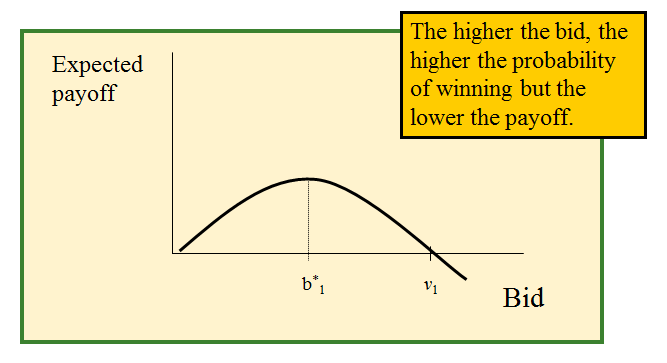
Strategic bidding – best bid is below true valuation
Auctions
Bidding strategy: Non-discriminatory auctions
(second-price sealed bid)
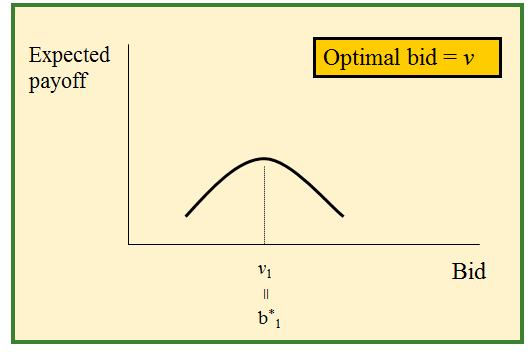
"Truthful” bidding – can’t do better than bidding true valuation
Auctions
Revenue Equivalence Theorem: In the benchmark case, all auction types have the same expected payoffs.
Lecture 23
By umich
Lecture 23
- 638



